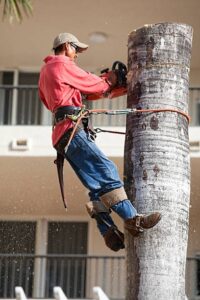Palm trees pose a considerable danger to homes and other structures on your property, as their shallow roots can damage sidewalks, foundations, and pavement.
Before cutting down a palm tree, it is necessary to secure it to the ground in case it topples over and causes damage.
Preparation
 Palm trees may need to be removed for many reasons, including being diseased or decaying, being damaged in a storm, interfering with property structures and blocking views. Whatever the case may be, the first step in the palm tree removal process should always be clearing around it – including any roots extending past their base of trunk or any trip hazards on the ground level that could present potential tripping hazards.
Palm trees may need to be removed for many reasons, including being diseased or decaying, being damaged in a storm, interfering with property structures and blocking views. Whatever the case may be, the first step in the palm tree removal process should always be clearing around it – including any roots extending past their base of trunk or any trip hazards on the ground level that could present potential tripping hazards.
Step two is to trim any out of control or overgrown fronds that have outgrown their intended place on the tree, cutting as close to its trunk as possible so as to minimise debris when the tree falls over.
Once all fronds have been stripped from a tree, it can be safely lowered to the ground. Due to its heavy weight and potential injury if it springs backwards, an assistant should assist during this process. A rope may also be used as security. Ideally, placement should pull it into place on its intended path of fall.
If a palm will be burned, it’s essential that a safe fire ring be created around its stump to protect any nearby flammable materials from ignition. Furthermore, it would be prudent to soak its stump and roots with gasoline to ensure it burns completely.
Stump Removal
There are a few effective strategies for eliminating palm tree stumps. Manual digging should be relatively straightforward given their shallow roots; another method involves using a stump grinder which will grind away at it until it no longer visible – however this option can be more expensive and may damage your lawn than necessary.
If you want a fast and inexpensive solution to getting rid of that pesky stump, cover it with a thick layer of mulch – this will promote microbe growth and speed up decomposition. Or take an eco-friendly palm tree removal process route by covering your stump with nitrogen-rich materials such as chicken manure, other manures, coffee grounds and bone meal to speed up decomposition more effectively and help it rot away more rapidly.
Burning is another option to remove palm stumps, though be sure to wear protective gear and take extra caution if choosing this path. Also make sure that there are no structures nearby that could be harmed by flames; additionally, it would be wise to cut any remaining fronds off before beginning, since these do not decompose quickly and could potentially fall on people or property if left on. For greater safety or if time doesn’t permit this removal process yourself consider hiring professional services instead.
Cutting the Trunk
Before cutting down a palm tree, take time to assess if its location near anything that could be damaged by falling debris (such as your home’s foundation or electrical wires). If this is the case, hiring professional services would likely ensure any harm done will be covered under homeowner’s insurance.
As it is recommended that a chainsaw be used, but if one is unavailable an axe or handsaw will also work. Start by making a notch cut at the base of the tree – this will allow you to control its direction of fall; for instance, if you wish for it to fall towards your house cut a triangle at that spot on its trunk.
Step two is essential, as improper cutting of the trunk could cause it to collapse and damage your property. Also be wary when initiating this palm tree removal process that no structures exist beneath the palm as its roots often reach into potentially hazardous places such as water or sewer pipes.
If the stump is in a convenient area, it may be possible to dig out using only a spade or similar tool; however, for larger stumps it will likely require something heavier.
Getting Rid of Debris
When you remove a palm tree, not only the stump needs to go; its leaves, fronds and seed pods must also be properly disposed of.
Homeowners may find this task complicated and require special equipment that may be difficult to source, making professional arborists an invaluable asset when it comes to getting rid of palm trees safely and effectively. Arborists know exactly how to safely cut down palms while considering potential utility lines or structures before beginning work on them.
Rotting palm stumps can not only be unsightly but can also attract pests and other unwanted insects to your property. Furthermore, they pose an unseen safety risk as they could fall onto vehicles or pedestrians nearby and even block drainage pipes – not to mention being unsightly!
Digging out palm stumps may be possible but may be impractical if they’re located close to utility lines or other structures. A better option would be hiring a stump grinder which will turn wood chips into mulch that can be added back into your landscaping project.
Though not an easy process, removing a palm tree safely is possible with careful planning and consideration. Rushing this palm tree removal process could have serious repercussions for surrounding area and property; to learn more about proper lawn care to prevent the need for Palm Tree removal contact Nozzle Nolen for a complimentary evaluation of your home and lawn.